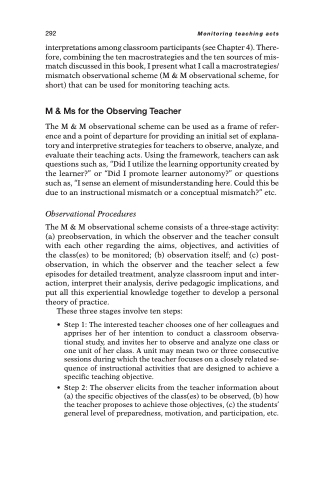Page 304 - Beyond Methods
P. 304
292 Monitoring teaching acts
interpretations among classroom participants (see Chapter 4). There- fore, combining the ten macrostrategies and the ten sources of mis- match discussed in this book, I present what I call a macrostrategies/ mismatch observational scheme (M & M observational scheme, for short) that can be used for monitoring teaching acts.
M & Ms for the Observing Teacher
The M & M observational scheme can be used as a frame of refer- ence and a point of departure for providing an initial set of explana- tory and interpretive strategies for teachers to observe, analyze, and evaluate their teaching acts. Using the framework, teachers can ask questions such as, “Did I utilize the learning opportunity created by the learner?” or “Did I promote learner autonomy?” or questions such as, “I sense an element of misunderstanding here. Could this be due to an instructional mismatch or a conceptual mismatch?” etc.
Observational Procedures
The M & M observational scheme consists of a three-stage activity: (a) preobservation, in which the observer and the teacher consult with each other regarding the aims, objectives, and activities of the class(es) to be monitored; (b) observation itself; and (c) post- observation, in which the observer and the teacher select a few episodes for detailed treatment, analyze classroom input and inter- action, interpret their analysis, derive pedagogic implications, and put all this experiential knowledge together to develop a personal theory of practice.
These three stages involve ten steps:
• Step 1: The interested teacher chooses one of her colleagues and apprises her of her intention to conduct a classroom observa- tional study, and invites her to observe and analyze one class or one unit of her class. A unit may mean two or three consecutive sessions during which the teacher focuses on a closely related se- quence of instructional activities that are designed to achieve a specific teaching objective.
• Step 2: The observer elicits from the teacher information about (a) the specific objectives of the class(es) to be observed, (b) how the teacher proposes to achieve those objectives, (c) the students’ general level of preparedness, motivation, and participation, etc.


